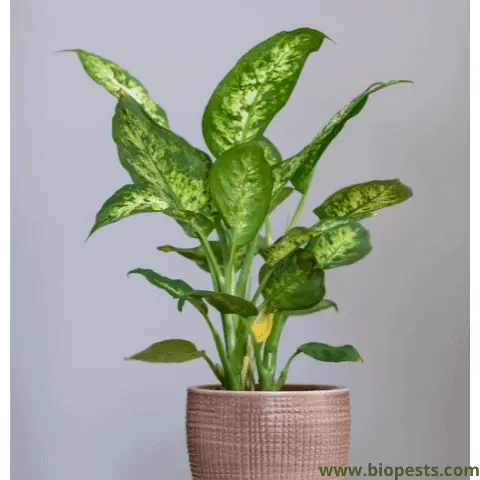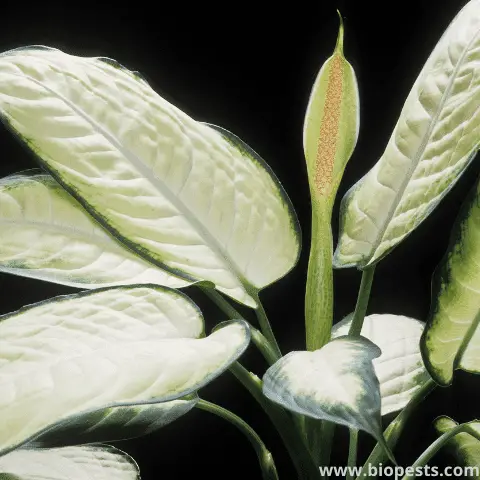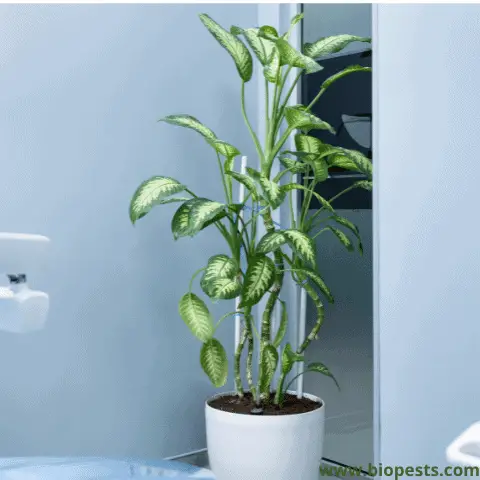Dumb canes are fairly common houseplants, decorating homes and workspaces everywhere. Being someone who can’t resist having greenery around the house, caring for my plants is always a priority. But you must know precisely what you need to do, so how do you help a top-heavy dumb cane plant?
Repotting, fertilizing, and placing a dumb cane plant into a better-lit area are all ways you can try to treat a top-heavy plant. However, if all else fails, you should cut the entire plant back to around 6 inches, encouraging new, healthy, and thicker growth.
Dumb cane plants can often become top-heavy or begin to lean and deteriorate for other reasons. Knowing how to care for your plant correctly can prevent various issues, including the unhealthy growth of a top-heavy plant. However, cutting the plant down and beginning from just a few inches is a viable last resort for dumb canes.
How to Help Top Heavy Dumb Cane Plants
Dieffenbachia (dumb cane plant) is a genus of tropical plants. Some species are commonly grown as ornamental plants, particularly houseplants. A healthy dumb cane plant has thick, jointed stems or stalks, broad variegated leaves, and grows between 3 – 6 feet. However, these lush plants often run into problems caused by incorrect care and placement.
Thankfully, these plants are relatively versatile and can withstand some neglect and poor treatment – not too much. They are also fantastic at regenerating themselves if you have to cut them down and start over, meaning that you should be able to keep the same plant alive for a very long time.

Dieffenbachias are known as dumb canes due to the toxic sap that inflames the tongue and throat, causing a temporary inability to speak. The entirety of this plant is toxic, so be sure to keep them away from children or animals who may want to take a curious bite of a leaf. Furthermore, always wash your hands after handling these plants.
Helping a Top-Heavy Dumb Cane Plant
If your dumb cane plant is thin and leggy, growing tall and stretched as opposed to developing healthy, robust stalks, you may find that it is tipping or falling over. This unnatural and unhealthy growth is commonly caused by the plant feeling stressed. Dumb canes are stressed by improper care, poor placement, and other environmental factors.
A few methods you can help the plant recover and naturally counter being top-heavy is as follows.
- Repotting – It is possible the proper and healthy growth of your plant is being limited by a pot that it has outgrown. Repotting the plant in a container that is roughly 1 – 2 inches wider than the root ball would be ideal. Ensure that the pot has drainage holes.
- New Soil – Use new potting soil formulated for houseplants that come from a sealed container. Using soil previously exposed to the elements can contain insects or their eggs and other contaminants that can weaken the plant and stunt its growth.
- Fertilizing – Use water-soluble houseplant fertilizer, diluted to half strength every two weeks during the growing season. Dumb cane plants grow very slowly during the winter months and cannot use fertilizer efficiently, resulting in weak growth and brown leaves.
- Moving – Place the plant next to a sunny window to get lots of natural light, but do not place them indirect light as this is damaging. They do well in areas between 60° F / 15° C – 75° F / 24° C. Begin by placing the plant in its new spot for 15 minutes, gradually increasing its exposure by 15 minutes every week until it remains in the new area for at least an hour with no signs of stress – such as wilting. Additionally, keep it away from cold drafts.
- Watering – Be sure to water the dumb cane plant properly, adding water when the top inch of soil is completely dry to touch. Spray and dust leaves with a gentle spray of water. The plant should not sit in water or wet soil; otherwise, the roots will rot.
However, if these methods prove ineffective, then you may need to resort to more drastic measures. Your best solution would be to cut the entire plant back to a height of 6 inches. Cut ¼ inch above a ridge or node, using the proper tools – a clean, sharp blade or pruning tool. Furthermore, give the plant optimal growing conditions as described above to prevent a repeat of this poor growth. The dumb cane plant will then grow from the node, creating healthier and thicker stalks. This is also necessary for a particularly leggy and top-heavy plant that is too severe for the above treatment recommendations.
A Leggy but Not Top-Heavy Dumb Cane Plant
You may find that your dumb cane plant is tipping over, despite not being very top-heavy. It is possible that the stalks of a dumb cane plant may grow or begin to curve and lean. This behavior may come across as strange in a plant that is not experiencing stress from being top-heavy.
This, however, is a common problem amongst older dumb cane plants which have never been pruned. A dumb cane’s leaves are relatively heavy compared to the thickness of its stems, and new growth will always be at the top of the plant, even as it loses its lower leaves. Eventually, this leads to the lower stems becoming bare, and the weight of the upper leaves begins to weigh down on the stems, tilting them.
Considering that the plant is continually growing, there is no long-term way to prevent the plant from leaning. However, the overall solution is pruning the older stems. Start with the tallest stem, cutting it down to approximately 2 inches above the soil. You should be able to see new growth within a month. This pruning will eliminate the bare stem, introducing growth lower down and providing stability. This will stop the stem from leaning.
How to Make a Dumb Cane Plant Grow Bushier
Regularly ensuring bushier growth will prevent your dumb cane plant from becoming leggy and top-heavy. So, how do you help a dumb cane plant grow bushier?
Pruning is the best way to encourage bushy growth in dumb canes – the process causes no harm to the plant and allows for healthy, beautiful growth. You should prune the new growth at the top regularly. Pruning out new top growth will encourage your plant to grow bushier and stay more compact.
When pruning, ensure you are using a sharp, clean blade or pruning tool. You should cut just above a node – the small swelling where a leaf grows – this way, the foliage will regrow beneath the cut, making the plant bushy. You should not remove too much growth at a time; a common rule is no more than a third.
Dumb Cane Plant Problems
Like Fittonia (nerve plant), Dieffenbachias (dumb canes) are very expressive plants, making it easy to spot when something is amiss. The first signs of a problem with dumb canes are their leaves turning yellow and falling off. Additionally, when a dumb cane plant is under stress, they will become thin and leggy, opposed to their thick stalks. These warning signs should make it easy to identify and remedy the problem before the plant dies.
Dumb Cane Plant Pests and Diseases
Pests cause problems for most indoor plants, and dumb canes are no different. Dumb canes are typically affected by spider mites, aphids, mealybugs, and scale insects. Spotting these pests should not be difficult. Check under yellow leaves for webby material, which suggests a spider mite infestation; meanwhile, aphids can be spotted crawling all over the leaves.
Here are a few simple ways to solve a pest problem:
- Insecticidal Soap – Spray on the plant to kill soft-bodied insects – it won’t damage their eggs. Here is an article that will explain how to make your own insecticidal spray at home.
- Neem Oil – Use a cotton ball to wipe the oil on the leaves and suffocate the pests.
- Rubbing Alcohol – Spray on the plant to dehydrate and kill spider mites. If your plant is sensitive, dilute with water. Here is an article that explains how to rub alcohol on our plants.
Additionally, red spider mites usually appear in low humidity; keeping it high should deter them.
Moreover, fungal and bacterial pathogens which affect dumb canes are fungal spot, stem rot, root rot, bacterial blight, soft rot, and Dasheen mosaic virus. Usually, removing infected leaves and spraying the plant with a fungicide should solve fungus-related problems.
Otherwise, for issues like steam and root rot, you should gently wash the diseased roots and remove all brown and soft parts of the roots with clean tools. Then you should replant the infected plant into fresh soil and good drainage to ensure it is not sitting in water.
Root System Issues
Dumb canes are prone to being root-bound and have extensive root systems, which, when they are tightly wound, cause the plant to suffer. To tell if the plant is getting root-bound, look at the pot’s drainage holes. If the roots are coming out through the holes, the plant is root-bound.
Transferring the plant to a bigger, better-fitting pot should solve this issue. However, ensure that the pot is not too big; otherwise, it will expose your dumb cane to other health issues.
Caring for a Dumb Cane Plants
Dumb canes are an extremely easy houseplant to care for, making it no mystery that they are some of the most common houseplants, often sold in garden centers. Although caring for dumb canes isn’t difficult, it is still vital to adhere to the growing requirements to keep this plant alive and thriving.
Sunlight & Climate
Dumb canes are tropical plants commonly found on forest floors. Thus, they thrive in partially shady conditions and don’t do well with a lot of heat. However, they love humidity and moisture in the air.
If a dumb cane is in bright or direct sunlight, it will become stressed, droop and die. To avoid this, keep your plant away from windows that receive a lot of light. They can still be around these windows, as long as all the light it receives is indirect and soft. Sunlight shining directly onto a dumb cane’s leaves will scorch and kill them.
Dumb canes should be kept in 60° F / 15° C – 75° F / 24° C conditions to keep these plants happy and healthy. Furthermore, your goal should be to maintain a 60 percent humidity level throughout the year. A drafty area can also negatively affect dumb canes. The temperatures need to remain warm and consistent.
Moving your dumb cane outside for the summer will allow it to flourish. Much like when you keep it indoors, make sure the weather is not too extreme, and you keep them in a shady area. While they suffer in extreme heat, they can still tolerate a warmer climate. However, dumb canes have zero tolerance for the cold, so be sure to bring them back indoors when the weather begins to cool again.
Watering
When a dumb cane is over or underwatered, the leaves will turn yellow, and the plant will show signs of being distressed.
Overwatering: Too much of anything is never a good thing. Not only does overwatering run the risk of drowning your plant, but it also means that the roots are sitting in wet soil, usually leading to root rot and fungus gnats. This will all lead to your plant dying.
If you have overwatered your plant, let the root system dry out and wait 7 – 10 days between watering. If the soil is not drying as fast as you wish, this article will tell you what to do.
Remove all yellowing and dying leaves and replant the plant into new soil and a pot with good drainage.
Underwatering: When the soil is too dry, and your dumb cane isn’t getting enough water, the leaves will turn yellow, then brown, and the plant will eventually die.
Proper Watering: The top inch of soil should be dry to touch if you want to water your plant. Additionally, having the correct sized pot and proper drainage will protect your dumb cane from any water-related damage and problems.
Soil & Potting
In accordance with a good watering schedule, dumb canes should not be sitting in wet soil. This can cause root rot and fungus gnats.
If your plant is in a pot too large for the root system, it will suffer. The soil won’t dry enough in between watering, resulting in the same issues presented through overwatering. There should be a maximum of 2 inches around and beneath the root system when choosing a pot. The pot should also have sufficient drainage so it is not sitting in water.
Additionally, you should remove any pebbles or sand sitting on top of the soil as they prevent oxygen from entering the soil and allow it to dry out properly. Letting the top inch of soil dry out will benefit the plant and deprive any gnat larvae of moisture which they need to survive.
Not getting enough nutrients is another reason your dumb cane may have yellowing leaves. If it remains nutrient deficient for an extended period of time, it may die. Dumb canes thrive in pure peat moss of 1:1 peat moss and perlite mix. Additionally, they do well in a 1:1:1 peat moss, perlite, and soil mix. But never plant a dumb cane in pure soil with no peat moss, as the plant will receive no nutrients and become stressed and unhealthy.
Blooming
It is rare for dumb cane plants to bloom indoors, and their blooms are not showy, to begin with. They may produce buds, but they will only bloom in perfect conditions, and if they do flower, it will not be a regular occurrence.

Dumb canes need a lot of bright but indirect light to bloom. Seeing as direct sunlight damages the plants, it can be challenging to get the conditions just right. Blooming is rare in many houseplants, so if your dumb cane does bloom, you must continue with quality care during and after, as the plant may die when it is finished blooming.
Conclusion
To remedy a top-heavy dumb cane plant, you can attempt repotting, fertilizing, and placing the plant in better-lit conditions. These methods will usually catch the source of your plants’ distress and fix the problem at its roots. Although, cutting the plant down, so it regrows is a viable option.
Dumb canes are relatively easy plants to care for when they are in their ideal conditions. Their dramatic reactions to improper care will signal anyone about a problem they are experiencing, making it easy to find and fix any problem before any extreme damage is done to the plant.
Some of the links above are affiliate links, meaning at no additional cost to you, I will earn a commission if you click through and make a purchase.

